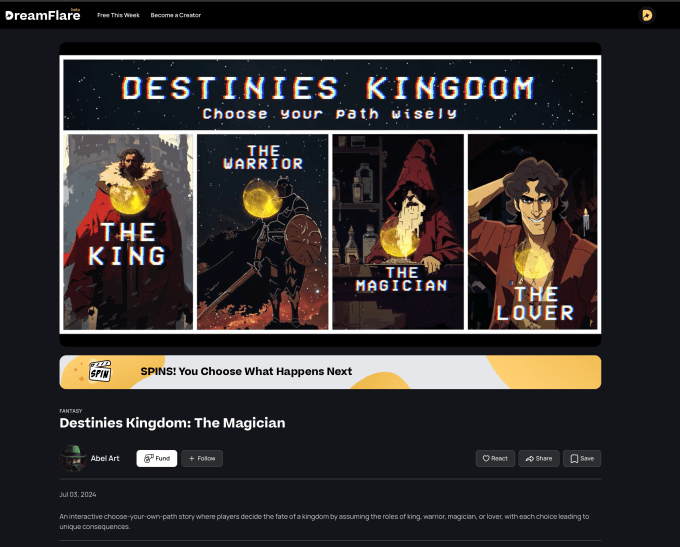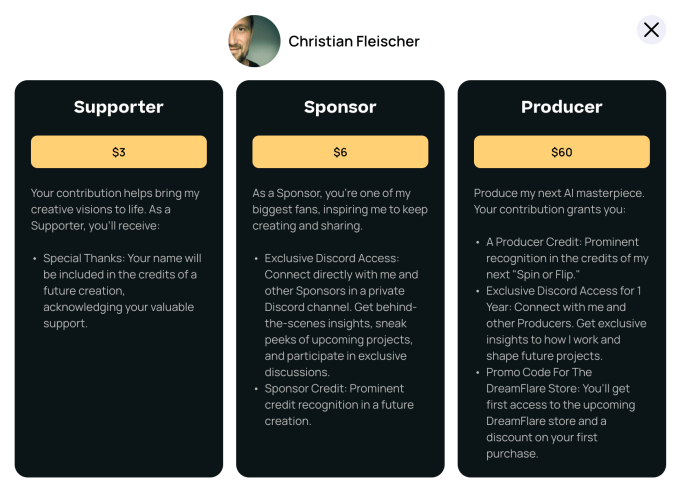Ex-Googler joins filmmaker to launch DreamFlare, a studio and streaming platform for AI-generated video
A startup called DreamFlare AI is emerging from stealth on Tuesday with the goal of helping content creators make and monetize short-form AI-generated content.
The company, co-founded by former Google employee Josh Liss and documentary filmmaker Rob Bralver, does not make or sell its own AI technology to create video. Rather, it's envisioned as a sort of studio where creators work with professional storytellers to create video using third-party AI tools like Runway, Midjourney, ElevenLabs, and others. The videos will then be distributed through a subscription-based online service. Creators will earn money from revenue-sharing on subscriptions and advertising, as well as a few other options.
DreamFlare will offer two types of animated content on the platform: Flips, which are comic book-style stories with AI-generated short clips and images that users can scroll through, and Spins, which are interactive choose-your-own-adventure short films where viewers can change certain outcomes of the story.
The launch of DreamFlare comes at a time when artists in Hollywood see AI technology as a threat. A 2024 study commissioned by the Animation Guild, a union for animation artists, found that 75% of film production companies using AI have decreased or eliminated jobs.
Despite these concerns, DreamFlare insists it’s creating a new space for creators to earn revenue from a new form of entertainment; it isn’t replacing anyone’s job.
“It’s an opportunity for creators to democratize storytelling,” Liss told TechCrunch. “We are excited to give human beings the opportunity to leverage this tool to tell exciting new stories,” he added.

Among those optimistic about AI entertainment and video platforms like DreamFlare is FoundersX Ventures, which has invested. The company also claims it has creative partnerships with various entertainment industry executives, including those from Disney, Netflix, and Universal. Additionally, DreamFlare says it's partnered with “Oscar- and Emmy-winning filmmakers and showrunners,” according to Liss, who said that they are “currently staying anonymous because of the controversy around [AI-generated content.]”
The company says it has raised $1.6 million in funding to date.
How DreamFlare works
Creators on DreamFlare are permitted to use any existing AI tool that offers paid plans, but many of these tools have ethical and legal questions surrounding them. For example, OpenAI, the company behind the Sora model, does not disclose how it procures training videos.
DreamFlare claims to have a rigorous review process to ensure submissions are not based on copyrighted material and does not accept R-rated content. When published content does not meet these standards, the platform has a DMCA takedown notice for anyone who thinks their copyright has been infringed.
“We’re always trying to control quality, safety, and legality before anything is published on the platform,” Bralver explained.
When creators successfully pass DreamFlare’s application process, they work alongside the creative team on story development. (According to the company, DreamFlare team members are former Disney and Universal executives who have chosen to remain anonymous.)
While creating content inspired by copyrighted intellectual property like “Star Wars” isn’t allowed, public domain characters are free game, which is why there are titles on the platform related to Little Red Riding Hood, Alice in Wonderland, Peter Pan, Frankenstein, and Thor, among others.
From what we saw during a demo of the platform, the quality of AI-generated video output was decent enough, albeit with occasional jerky and a sometimes strange-looking animation style. (It’s definitely nowhere close to being Pixar-level quality.) Some of the content on DreamFlare is original and creative, such as one about a cat detective who had a little too much catnip.
https://www.youtube.com/watch?v=h-5pNXvOrp0&feature=youtu.be
Creators can earn money on DreamFlare in four ways: platform revenue sharing, cuts on ad revenue, tips from fans, and a soon-to-be-launched marketplace for creators to sell merchandise.
There's also a fan fund that allows followers to support content creators and participate in the process. For example, if a user pays for the Supporter package, they will be featured in the credits of a future video. If a follower wants to pay more, they have the opportunity to connect with the creator in a private Discord channel. The highest contributing followers are promoted to producer status and get exclusive insights into how a creator makes their content.

At launch, around 100 content creators are on the platform, providing a diverse range of content, from sci-fi and comedy to fantasy, mystery, and more.
DreamFlare’s premium membership costs $2.99 per month or $24 per year. It currently has a limited-time offer that includes a one-year subscription for $9.99. There is also free weekly content to try and get people hooked on the idea.


